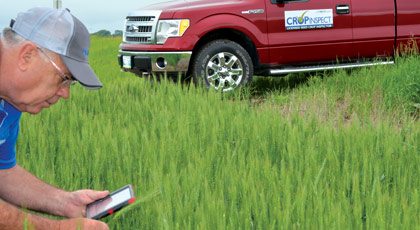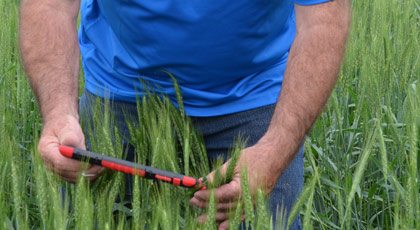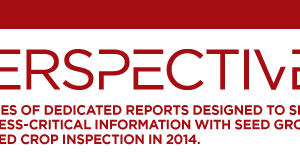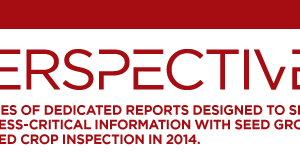From the Field
At this time, all of the certification application deadlines have passed and the paperwork necessary for field inspection should be filed. Germination talks with inspectors to see how things are going on their end.
2014 marks the first year that seed growers had to designate an Authorized Seed Crop Inspection Service (ASCIS) on their application. This requirement was brought about at the direction of the Canadian Food Inspection Agency.
Danielle Markert, a certified crop adviser and lead inspector with Agri-FX Inc., believes that the rollout of the new alternative inspection service has gone pretty well. “Both CFIA and the Canadian Seed Growers’ Association have done a good job at providing lots of information to inspectors and ASCIS’s regarding the inspection process, what is expected of them and technical support,” says Markert, who is also a professional agrologist based in Magrath, Alta.
Authorized seed inspectors are just getting into the heavy inspection period. All eyes are watching.
However, Markert says one of the hurdles that seed growers have had to overcome is learning how to use the new online application system. “The screen times out if it has been inactive for too long, which causes some people to lose information and then they have to re-input it,” she says. “As a solution, some growers are printing off a copy of the online application, filling it in by hand, and then transferring that information back to the online copy.”
Gordon Butcher, CEO of AgCall — which created CropInspect, agrees with Markert. “Progress is being made; however, there were many challenges in the training of new inspectors prior to spring,” he says. “Basically, CFIA was late in offering classroom training for the spring of 2014. In certain regions, it did not allocate enough training spots to meet the requirements of the ASCIS.”
Germination had the opportunity to catch up with Michael Scheffel, CFIA Seed Section national manager. “Today [June 25] will be the first day for seed crop inspection,” he says, noting that the field to be inspected is a fall rye field in southern Alberta. “All of the implementation work that we’ve done for the past 28 months really starts today.”
Scheffel says that his team won’t really know how the alternative service delivery is going until a couple hundred inspections are done. When it’s all said and done, he expects that there will be about 16,000 inspection applications.
Admittedly, Scheffel says they weren’t prepared to train the large number of people who had requested field inspection training. “We had way more people asking for training than we had the capacity to train,” he says. “But we have more than enough licensed crop inspectors to get the job done. This past year, we trained more than 150 individuals and more than 180 individuals are licensed — some of which are former CFIA employees who didn’t need training. I expect about another 100 individuals to be licensed in the next three weeks and be able to do inspections yet this summer.”
Creating an Inspector Community
The creation of CropInspect is a direct result of CFIA’s decision to outsource seed crop inspection services to licensed inspectors. CropInspect is made up of a team of more than 60 trained inspectors across Canada and is designed to deliver dependable seed crop inspection services to the Canadian seed industry from British Columbia to the Atlantic provinces.
“Our goal was to help make seed growers transition into the new seed crop inspection framework as smooth as possible,” says Laurie Hayes, project manager for AgCall’s CropInspect service. Hayes manages AgCall’s licensed crop inspectors and the day-to-day operations of CropInspect from her office in Saskatoon, Sask.
Butcher explains that the CropInspect website allows growers to create an account online, build a quote, book an inspection, issue an invoice and make a payment. But “some growers have been unclear on the steps necessary to sign up with an ASCIS and tried to sign their fields up with CSGA,” he says. “There has been some price shock by a few growers; however, the majority realize that change is necessary.”
Think of the changes with the long-term in mind. “The new system is a positive change,” says Kevin Zaychuk, crop inspection administrator for 20/20 Seed Labs. “While we’re still in the first year, there are some improvements to be made, such as data transfer from CSGA to inspectors. One of the challenges growers have is the varying levels of computer use and their ability to adapt to the new system. I believe it’s a positive move, we just need to get through the first year or two.”
Markert, who is inspecting fields in southern Alberta and the southern part of British Columbia, says it’s too early to know for sure how this season is going to go, but she thinks that everyone is trying to make the transition as easy as possible.
Scheffel says come November, CFIA will evaluate both the program and inspectors. “Throughout the season, CFIA will inspect 10 per cent of the fields that licensed inspectors inspect,” he says. “We will compare CFIA results with the results from inspectors and look at similarities and differences and provide feedback.
“We’ll also sit down face-to-face with all 24 quality managers of the Authorized Seed Crop Inspection Services and have a two-way conversation. This will be a chance for us to share our observations, as well as an opportunity for them to give us feedback. Was the training adequate? Are there aspects that need to be changed or modified? Next year, we’ll tweak the program based on feedback, train more inspectors and add new crops to the mix.”
 |
For complete information about the Canadian Food Inspection Agency’s Seed Program Quality System Procedure and roles and responsibilities regarding the Authorized Seed Crop Inspection Services, visit tinyurl.com/inspection-gc-ca. |
















